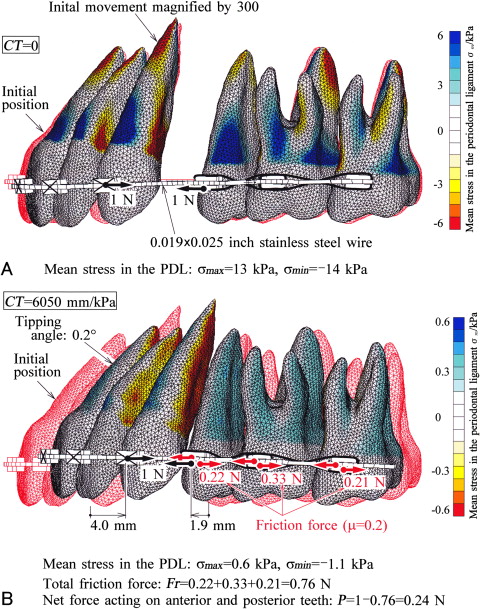Introduction
En-masse sliding mechanics have been typically used for space closure. Because of friction created at the bracket-wire interface, the force system during tooth movement has not been clarified.
Methods
Long-term tooth movements in en-masse sliding mechanics were simulated with the finite element method.
Results
Tipping of the anterior teeth occurred immediately after application of retraction forces. The force system then changed so that the teeth moved almost bodily, and friction occurred at the bracket-wire interface. Net force transferred to the anterior teeth was approximately one fourth of the applied force. The amount of the mesial force acting on the posterior teeth was the same as that acting on the anterior teeth. Irrespective of the amount of friction, the ratio of movement distances between the posterior and anterior teeth was almost the same. By increasing the applied force or decreasing the frictional coefficient, the teeth moved rapidly, but the tipping angle of the anterior teeth increased because of the elastic deflection of the archwire.
Conclusions
Finite element simulation clarified the tooth movement and the force system in en-masse sliding mechanics. Long-term tooth movement could not be predicted from the initial force system. The friction was not detrimental to the anchorage. Increasing the applied force or decreasing the friction for rapid tooth movement might result in tipping of the teeth.
Editor’s comment
Orthodontists have long debated the efficiency of closing maxillary extraction spaces either by retracting canines first and then the incisors or by the en-masse retraction of all 6 anterior teeth in 1 procedure. I generally used en-masse space closure unless I thought anchorage was critical; then I used the 2-step procedure. I thought I was conserving anchorage by using this more time-consuming option, but is that really true? Heo et al compared the degree of anchorage loss of the posterior teeth between the 2 methods and showed that en-masse space closure was not detrimental to the anchorage when compared with 2-step retraction. The purpose of this research was to evaluate the use of the finite element method to measure the forces acting on the teeth during orthodontic space closure movements with en-masse sliding mechanics.
Following the sliding mechanics described by McLaughlin and Bennett, these authors designed a finite element model and carried out simulations of long-term tooth movement. The results showed that the anterior teeth tipped with the initial force system; after that, they moved bodily over a long period of time. The authors were quick to note the difficulty of predicting long-term tooth movement from the initial force system. “For this reason, simulations of long-term tooth movement are necessary, and the calculation method in this article is important for this purpose.” Irrespective of the amount of friction, the ratio of movement distance of the posterior teeth to that of the anterior teeth became almost the same. It was demonstrated that the friction was not detrimental to the anchorage. In this excellent study, finite element simulations have clarified tooth movement and the force system for the use of en-masse sliding mechanics.





